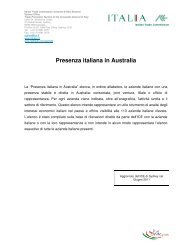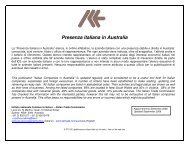Price Determination in the Australian Food Industry A Report
Price Determination in the Australian Food Industry A Report
Price Determination in the Australian Food Industry A Report
Create successful ePaper yourself
Turn your PDF publications into a flip-book with our unique Google optimized e-Paper software.
Marg<strong>in</strong>s <strong>in</strong> <strong>the</strong> cha<strong>in</strong><br />
• Our analysis of <strong>the</strong> marg<strong>in</strong>s captured by each major sector engaged <strong>in</strong> <strong>the</strong> rice value cha<strong>in</strong> is<br />
represented below.<br />
Figure 111. Share of retail sales value of rice, long gra<strong>in</strong>, 1kg, average all<br />
grocery retail sales<br />
%<br />
100<br />
80<br />
60<br />
retail<br />
processor<br />
grower<br />
40<br />
20<br />
0<br />
2000<br />
2003<br />
Source: <strong>Industry</strong> sources<br />
• This has been compiled by reference to <strong>the</strong> average retail value of long gra<strong>in</strong> product <strong>in</strong> <strong>the</strong><br />
<strong>Australian</strong> market (per ABS data), <strong>the</strong> calculation of <strong>the</strong> apparent average net wholesale sell<strong>in</strong>g<br />
price and <strong>the</strong> calculation of a derived farmgate return ga<strong>in</strong>ed from <strong>the</strong> retail products market.<br />
• The past several years have seen a gradual <strong>in</strong>crease <strong>in</strong> <strong>the</strong> share of <strong>the</strong> retail sales dollar (per<br />
kg) captured by <strong>the</strong> retail sector through a comb<strong>in</strong>ation of <strong>in</strong>creas<strong>in</strong>g retail sell<strong>in</strong>g prices,<br />
<strong>in</strong>creas<strong>in</strong>g use of private label products and a greater <strong>in</strong>vestment <strong>in</strong> trade spend<strong>in</strong>g and<br />
promotional activities by marketers.<br />
Drivers of cost<br />
• Variation <strong>in</strong> <strong>the</strong> major costs <strong>in</strong> <strong>the</strong> rice value cha<strong>in</strong> are largely determ<strong>in</strong>ed by <strong>the</strong> annual size of<br />
<strong>the</strong> rice crop.<br />
• The major cost <strong>in</strong> <strong>the</strong> production of bulk milled rice is <strong>the</strong> raw material which is essentially<br />
struck as a residual amount after <strong>the</strong> <strong>in</strong>dustry meets major costs of mill<strong>in</strong>g, market<strong>in</strong>g and<br />
distribution.<br />
Figure 112. Share of rice mill<strong>in</strong>g costs<br />
%<br />
100<br />
80<br />
60<br />
40<br />
20<br />
0<br />
1998 1999 2000 2001 2002<br />
Source: Sunrice annual report 2003<br />
f<strong>in</strong>ance<br />
depreciation<br />
• The <strong>Australian</strong> <strong>in</strong>dustry has undertaken significant rationalisation of mill<strong>in</strong>g capacity and<br />
upgrad<strong>in</strong>g of technology <strong>in</strong> an ongo<strong>in</strong>g drive to deliver best practice and lower cost.<br />
• The local <strong>in</strong>dustry, unlike its competitors <strong>in</strong> most major rice grow<strong>in</strong>g regions around <strong>the</strong> world,<br />
receives no production subsidies.<br />
• This has led to a reduction <strong>in</strong> like-for-like conversion costs.<br />
freight<br />
labour<br />
rice<br />
<strong>Price</strong> <strong>Determ<strong>in</strong>ation</strong> <strong>in</strong> <strong>the</strong> <strong>Australian</strong> <strong>Food</strong> <strong>Industry</strong> A <strong>Report</strong><br />
103







